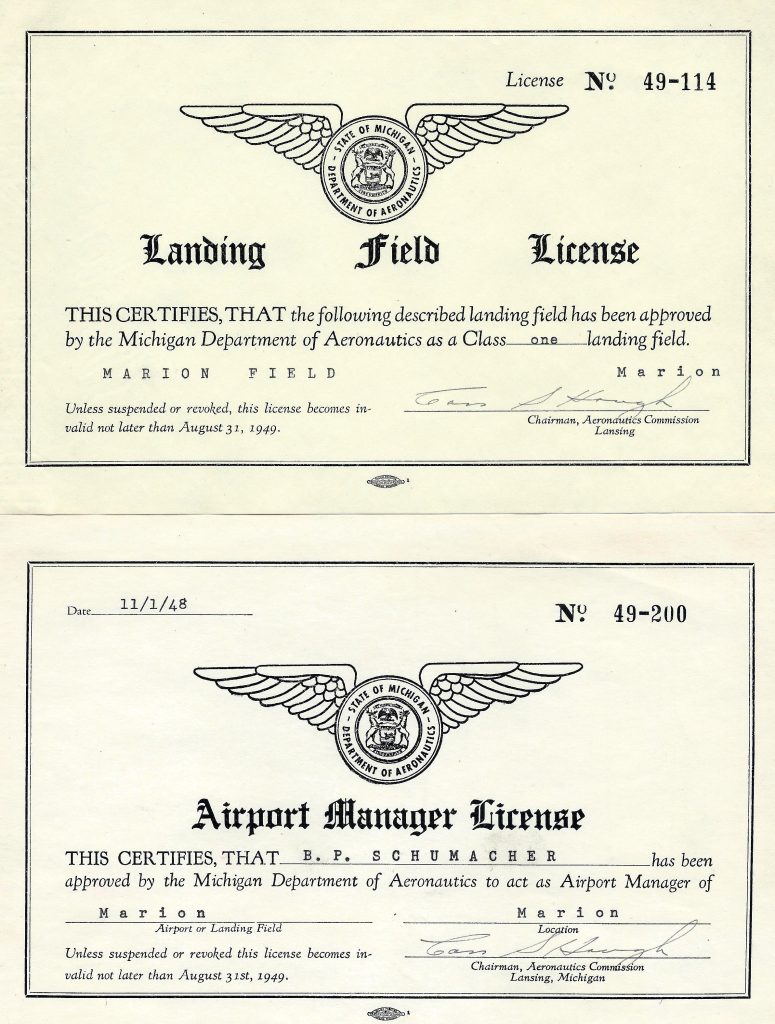
February has arrived. It’s the month of hearts and flowers, presidential birthdays and often cold and snow. It is the shortest month, preceding March, which many consider one of the longest. March is all that stands between us and the arrival of gentler weather. Some may be thinking of winging away to warmer climes for a break. There was a time when the first leg of such a journey could be started right here at home near Marion, Michigan. If you’re riding out winter at home I offer you some local travel history. The story of the Marion’s attempt at local air travel is at the same time forgotten by most, and completely new to others. Just short of four miles west of town, lost now under one of Highland township’s prize potato fields, are the runway ghosts of the short-lived Marion Airport. In 1946, spearheaded by Dr. Harry Willet, DO, a licensed pilot and avid flier, local like-minded residents and returning service men formed the Marion High Pointe Flying Association with 25 members. Officers were elected and committees designated. They leased 130 acres from John Hesselink. Members paid dues and aggressively raised funds, receiving the support of the community. Dr. Willet was elected President, Max Sneary-Secretary, Milo (Mike) Jenkins-Treasurer, Walt Richardson-Airport Manager and George Berry-Supt. of Construction. With Claude Sadler, Pete Jenema, Omer Hall, Forrest (Diz) Martin and Frank Berry Jr. on other work committees, the group set out to clear, level ground, grade, and gravel two runways. One, approaching 2,000 feet, ran southwest to northeast. The shorter, and less frequently used runway, ran north and south. Two corrugated hangars were built, one for Doc Willet and the other for Mike Jenkins. By the spring of 1947 the Association had established a first rate local airport. A number of Association members formed the Lame Duck Squadron Flying Club. Burton Brown, Skinny’s brother, was president. They purchased a Piper Cub and members began taking lessons. Pete Daugherty was the only licensed pilot at the onset. And with incentives from the Federal Government under the G.I. Bill, a flight instructor visited the facility several times a week to give lessons. It was a busy place for a few years, but by 1955, the flying association dissolved and potatoes once again grew where planes landed. Such was the short but sweet history of the Marion Airport and the Lame Duck Squadron. I never found any documentation or anyone who recalls exactly why the Marion Airport came to an end. The answer I heard most frequently was that the local fliers simply got busy with life. Those former soldiers became husbands and fathers and found jobs which kept them all busy. They simply got on with life and found greater demands on their time and money than flying. My dad and two uncles were involved with the project from the beginning. Dad was called to the Korean War. Uncle Bernie was busy with his growing grocery business. Uncle Frank moved away. The stories were much the same for other members. The plane was sold. Most likely, economics played a role in the demise of the airport. Evart’s Municipal Airport, supported by the city and the recipient of government funds, simply won the airport wars. If folks wanted to fly they used the Evart Airport, one in Cadillac, or established their own on the family farm. Doc Willet, who truly loved to fly, continued to do so for a few more years, taking along his wife Katherine or any of a number of others. I have three pages of black and white aerial photos of trees below, taken by my dad on an autumn afternoon flight with Doc. They flew over Houghton Lake and the Beaver Creek district near Grayling. Dad clicked away, taking lots of shots of the lovely autumn colors. Did I mention that they are black and white photos? Harry’s wife took some equally boring home movies from the air, too. If you are of a certain age you likely remember the Marion Airport. It was known more as an area, not necessarily as a viable working airport. When I was a kid the hills beyond the airport were a popular place to hunt mushrooms and wild flowers, arrived at by driving on one of the runway remnants. Others remember the road to the Scout camp and later the development on the Middle Branch River, known as The Escape. The flying world’s loss is our gain. Potatoes grown in Highland are known and appreciated far and wide. The sole surviving hangar still stores equipment these days, but with a more down to earth purpose.
